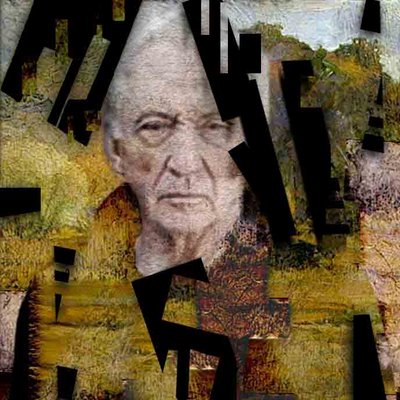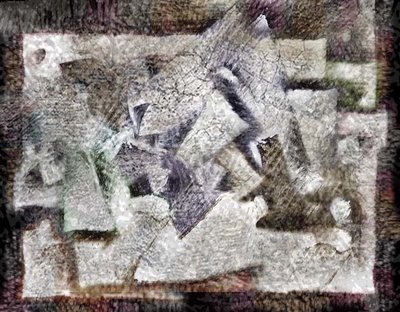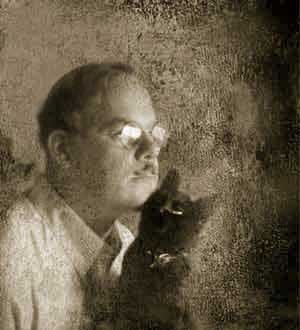28.7.06
24.7.06
Le Boucher (revision, 2006)
Following the editors' decision to post two versions of an early work, "Le Boucher," Bolto was prompted to revisit the composition, using his newly developed skills with digital media. The result is a representative example of recent experiments in what the editors would categorize as post-post-Maximalism.


22.7.06
Bolto and Soulages: tangencies
Bolto first encountered Pierre Soulages in 1943 following the latter's first solo Paris show. The two men found much in common, but aside from a few casual encounters at cafés in the Montparnasse district, their contact was slight untli at least 1957. During the late 1950s Bolto's experiments in what would later become known as Minimalism (another major innovation for which he has received insufficient credit), he entered into a prolonged series of discussions with Soulages on the subject of the color black. The specific content and outcome of these meetings have not been documented. During the past 10 years Bolto is known to have worked on a group of prints with Soulages at the latter's Denfert-Rochereau studio, but for reasons unknown to the public Soulages has refused to exhibit any of their collaborations, nor will he even acknowledge their work; nor indeed have recent promptings elicited comment from the elder artist (Bolto was born ca. 1902 - 1905, Soulages not until 1918).

Caricature of Bolto by Soulages (?), ca. 1950

Portrait of Soulages by Bolto (digital media collage), 1998
Among Bolto's many hobbies is the writing of sonnets. He kindly consented to share one with us for the blogsite. He has asked us to remind the readers that English is not his native language. Bolto worked directly from John Donne's model (Holy Sonnet XIV), as the scansion is very nearly identical.
Sonnet on seeing a new painting by Soulages

Pierre Soulages, Painting, 1957
Finer the core without than that within.
From there the deep, black, broad-inflected stroke
Extends its weight beyond the wash of oak,
Then homes to day's slack, darkling end, its twin.
Walnut, a noisome stream, will infect the pool,
Staining, now embalm'd in a raw vein of life,
Weakening toxins expos'd by painter's knife,
Parching, breathless, like gills straining at wool.
Yet wriggling again, it collides with death's train,
Too like itself to see or sense its wake,
And bleeding, it bleats with neither breath nor brain.
Spitting exhaust, it sputters up again,
Excretes yeasty curds of murk-amber moss,
A drunken, whorling gout of blackened dross.
Bolto, 1959 (with thanks to Louis)

Caricature of Bolto by Soulages (?), ca. 1950

Portrait of Soulages by Bolto (digital media collage), 1998
Among Bolto's many hobbies is the writing of sonnets. He kindly consented to share one with us for the blogsite. He has asked us to remind the readers that English is not his native language. Bolto worked directly from John Donne's model (Holy Sonnet XIV), as the scansion is very nearly identical.
Sonnet on seeing a new painting by Soulages

Pierre Soulages, Painting, 1957
Finer the core without than that within.
From there the deep, black, broad-inflected stroke
Extends its weight beyond the wash of oak,
Then homes to day's slack, darkling end, its twin.
Walnut, a noisome stream, will infect the pool,
Staining, now embalm'd in a raw vein of life,
Weakening toxins expos'd by painter's knife,
Parching, breathless, like gills straining at wool.
Yet wriggling again, it collides with death's train,
Too like itself to see or sense its wake,
And bleeding, it bleats with neither breath nor brain.
Spitting exhaust, it sputters up again,
Excretes yeasty curds of murk-amber moss,
A drunken, whorling gout of blackened dross.
Bolto, 1959 (with thanks to Louis)





